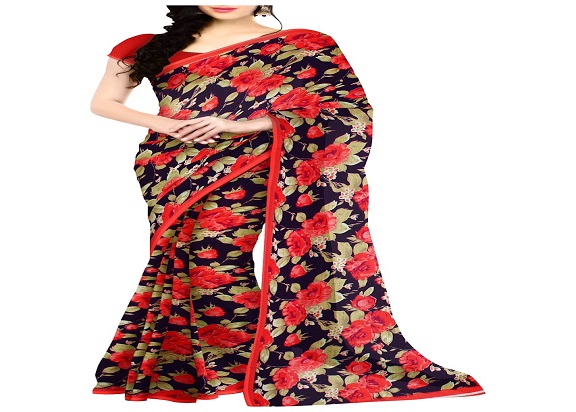Republic of India




Colours of the Flag: In the national flag of India the top band is of Saffron colour, indicating the strength and courage of the country. The white middle band indicates peace and truth with Dharma Chakra. The last band is green in colour shows the fertility, growth and auspiciousness of the land.

Motto: "Satyameva Jayate" (Sanskrit)
"Jana Gana Mana" (Hindi)
"Vande Mataram" (Hindi)

New Delhi is the capital of India and one of Delhi city's 11 districts.

Mumbai also known as Bombay, the official name until 1995) is the capital city of the Indian state of Maharashtra.
Hindi (Devanagari: हिन्दी), or Modern Standard Hindi (Devanagari: मानक हिन्दी: Mānak Hindī) is a standardised and Sanskritised register of the Hindustani language.
Indian English is any of the forms of English characteristic of India. English is a lingua franca of India.
79.8% Hinduism
14.2% Islam
2.3% Christianity
1.7% Sikhism
0.7% Buddhism
0.4% Jainism
0.9% Others
Indian

A demonym is a word that identifies residents or natives of a particular place, which is derived from the name of that particular place.
Examples of demonyms include Indian for a person of India.


 Narendra Damodardas Modi (Prime Minister)
Narendra Damodardas Modi (Prime Minister)

 Om Birla (Lok Sabha Speaker)
Om Birla (Lok Sabha Speaker)
Parliament of India

Rajya Sabha
Lok Sabha

Dominion - [15 August 1947]
Republic - [26 January 1950]

Indian Rupee (INR)
1,310,069,000
Culture of India
Our India



India is one of the world's oldest civilizations and one of the most populated countries in the world. The Indian culture, often labeled as an amalgamation of several various cultures, spans across the Indian subcontinent and has been influenced and shaped by a history that is several thousand years old. Throughout the history of India, Indian culture has been heavily influenced by Dharmic religions. They have been credited with shaping much of Indian philosophy, literature, architecture, art and music.Greater India was the historical extent of Indian culture beyond the Indian subcontinent. This particularly concerns the spread of Hinduism, Buddhism, architecture, administration and writing system from India to other parts of Asia through the Silk Road by the travellers and maritime traders during the early centuries of the Common Era. To the west, Greater India overlaps with Greater Persia in the Hindu Kush and Pamir Mountains. Over the centuries, there has been significant fusion of cultures between Buddhists, Hindus, Muslims (Sunni, Shia, Sufi), Jains, Sikhs and various tribal populations in India.
India is the birthplace of Hinduism, Buddhism, Jainism and Sikhism, collectively known as Indian religions.Indian religions are a major form of world religions along with Abrahamic ones. Today, Hinduism and Buddhism are the world's third and fourth-largest religions respectively, with over 2 billion followers altogether, and possibly as many as 2.5 or 2.6 billion followers. Followers of Indian religions – Hindus, Sikhs, Jains and Buddhists make up around 80–82% population of India.
National Symbols

Lotus (Nelumbo nucifera) is a sacred flower and occupies a unique position in the art and mythology of ancient India and has been an auspicious symbol of Indian culture.

Mango (Mangifera indica) originated in India and the country is home to more than 100 varieties of the fruit.

Ganga is the longest river of India with the most heavily populated river basin in the world. The river is revered by Hindus as the most sacred river on earth.

Indian banyan (Ficus bengalensis) root themselves to form new trees and grow over large areas. Because of this characteristic and its longevity, this tree is considered immortal and is an integral part of the myths and legends of India.

Bengal tiger (Panthera tigris tigris), the largest carnivore is found only in the Indian subcontinent and can be found in most regions of the country.

Gangetic dolphin (Platanista gangetica) is said to represent the purity of the holy Ganga River as it can only survive in pure and fresh water.
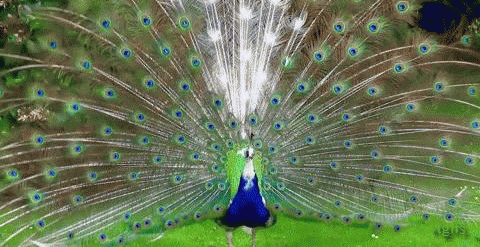
Indian peacock (Pavo cristatus) is designated as the national bird of India. A bird indigenous to the subcontinent, peacock represents the unity of vivid colours and finds references in Indian culture.
Family Structure And Marriage


A Hindu wedding is Vivaha (Sanskrit: विवाह) and the wedding ceremony is called vivaah sanskar in North India and kalyanam (generally) in South India. Hindus attach a great deal of importance to marriages. The ceremonies are very colourful, and celebrations may extend for several days. The bride's and groom's home - entrance, doors, wall, floor, roof - are sometimes decorated with colors, balloons,and other decorations.

Brahma Vivaah
It has the most supreme type of matrimony among all the eight types of marriages. In this type of marriage, the groom's family search for a suitable girl for their boy. Then the father of the bride invites the potential groom to his house. After making sure that the groom is a learned man and is of good conduct, the father gets his daughter married to him.

Prajapatya Vivaah
In this kind of marriage, the girl's father goes in search of a suitable groom. Since here the girl's father goes in search of a suitable guy, it is also considered as an inferior type of marriage.

Daiva Vivaah
It is an inferior type of marriage. The bride's family wait for a specific time to get her married. In that time if she is not able to find a suitable groom for herself, then she is married off to a priest during a sacrifice.

Arsha Vivaah
In this type of marriage, the girl is married to the sages. The bride is given in the exchange of two cows. Since this type of marriage involves business transactions, it is not considered a noble matrimony.

Asura Vivaah
In this type of marriage, the girl's family receives gifts and money from the groom. Due to this most of the times the groom is no match for the bride. But since the family receives money, the girl is forced to marry the mismatched groom.

Gandharva Vivaah
The modern form of this type of marriage is love marriage. A boy and girl get married in secret irrespective of whether the families agree to it or not.
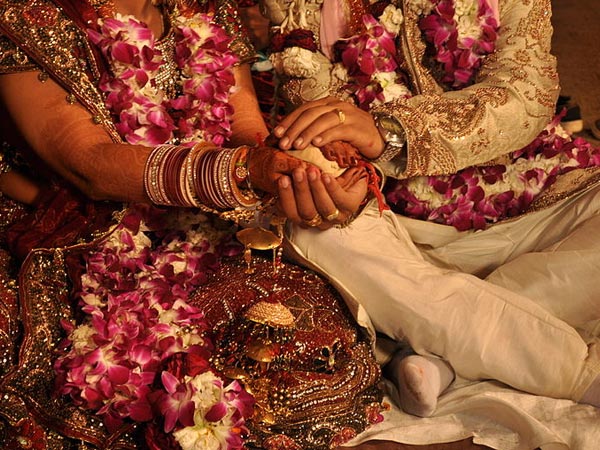
Rakshasa Vivaah
In this type of marriage, the groom fights the bride's family. He forcibly marries her against her will and takes her away.
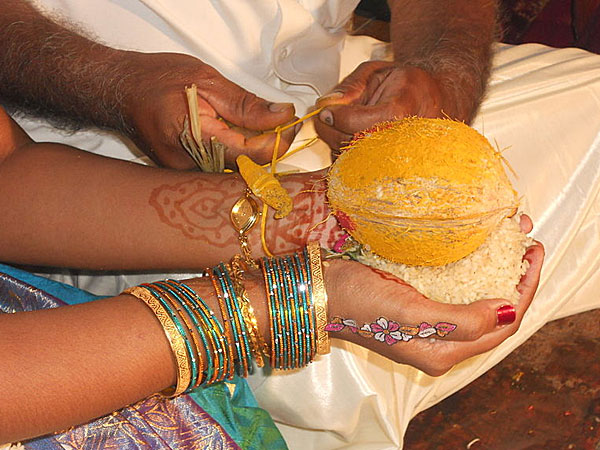
Paishacha Vivaah
In this a man stealthily seduces the girl and marries her when she is sleeping or is intoxicated or handicapped.

Arranged marriages have long been the norm in Indian society. Even today, the majority of Indians have their marriages planned by their parents and other respected family-members. In the past, the age of marriage was young. The average age of marriage for women in India has increased to 21 years, according to 2011 Census of India. In 2009, about 7% of women got married before the age of 18.

In Islam, marriage is a legal contract (Literary Arabic: عقد القران ʻaqd al-qirān, "matrimony contract"; Urdu: نکاح نامہ / ALA-LC: Nikāḥ-nāmah),(In Persian (Farsi): ازدواج (ezdevāj) (= marriage) and سند ازدواج or عقدنامه (Sǎnǎde ezdevāj; aqd nāmeh) for the certificate), between two people. Both the groom and the bride are to consent to the marriage of their own free wills.
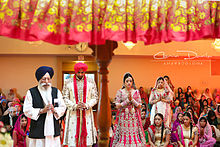
Most families combine the wedding ceremony with the engagement ceremony called the "kurmai", which is held just before the wedding vows or laava. The engagement ceremony can also be held as a separate event on a different day. It is usually conducted in the gurdwara or at the home of the groom-to-be. It involves ardas, kirtan, sagun (exchange of gifts) and langar. In the "sagaan" ceremony, the groom is presented with a kara, kirpan, Indian sweets, fresh fruits, dried fruits and nuts. The bride-to-be's family in turn are presented with garments and sweets.

Most Christian authorities and bodies view marriage (also called Holy Matrimony) as a state instituted and ordained by God for the lifelong relationship between one man as husband and one woman as a wife. They consider it the most intimate of human relationships, a gift from God, and a sacred institution. Protestants consider it to be sacred, holy, and even central to the community of faith, while Catholics and Eastern Orthodox Christians consider it a Sacrament. Biblically, it is to be "held in honour among all.
Greetings

Greeting is an act of communication in which human beings intentionally make their presence known to each other, to show attention to, and to suggest a type of relationship (usually cordial) or social status (formal or informal) between individuals or groups of people coming in contact with each other.
Greetings include Namaste in (Hindi and Sanskrit), Namaskar (Hindi)
Greetings include Juhar/Namaskar and Jai Jagannath in (Odia)
Greetings include Namaskar in (Marathi)
Greetings include Namaskara in (Kannada)
Greetings include Namaskaram in (Telugu, Malayalam)
Greetings include Vanakkam in (Tamil)
Greetings include Nomoshkaar or Ami Aschi in (Bengali)
Greetings include Nomoskar in (Assamese)
Greetings include Jai Shri Krishna in (Gujarati)
Greetings include Ram Ram or Sat Sri Akal in (Punjabi)
Greetings include Salaam-vaalaikum or Vaalaikum-salaam in (Urdu)
Festivals

India, being a multi-cultural, multi-ethnic and multi-religious society, celebrates holidays and festivals of various religions. The three national holidays in India, the Independence Day, the Republic Day and the Gandhi Jayanti, are celebrated with zeal and enthusiasm across India.

Navratri
Navratri celebrates either Durga or Rama depending on the region. Navratri (Sanskrit: नवरात्रि, literally "nine nights"), also spelled Navaratri or Navarathri, is a multi-day Hindu festival celebrated in the autumn every year.

Krishna Janmashtami
Krishna Janmashtami (Devanagari कृष्ण जन्माष्टमी, Kṛṣṇa Janmāṣṭamī), also known simply as Janmashtami, is an annual Hindu festival that celebrates the birth of Krishna, the eighth avatar of Vishnu.
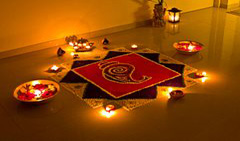
Diwali or Deepavali
Rangoli decorations, made using coloured powder or sand, are popular during Diwali. Also called Deepavali

Maha Shivaratri
Maha Shivaratri is a Hindu festival celebrated annually in honour of the god Shiva.

Ganesh Chaturthi
Ganesh Chaturthi (Gaṇēśa Chaturthī), also known as Vinayaka Chaturthi (Vināyaka Chaturthī), is the Hindu festival that reveres god Ganesha. A ten-day festival, it starts on the fourth day of Hindu luni-solar calendar month Bhadrapada, which typically falls in Gregorian months of August or September.

Durga Puja
Durga Puja, also called Durgotsava and Navaratri, is an annual Hindu festival in the Indian subcontinent that reveres the goddess Durga. It is observed in the Hindu calendar month of Ashvin, typically September or October of the Gregorian calendar.

Holi
Holi (Sanskrit: होली Holī) is a Hindu spring festival celebrated in India and Nepal, also known as the "festival of colours" or the "festival of love". The festival signifies the victory of good over evil, the arrival of spring, end of winter, and for many a festive day to meet others, play and laugh, forget and forgive, and repair broken relationships.

Raksha Bandhan
Raksha Bandhan, or simply Rakhi in many parts of India and Nepal, is a Hindu religious and secular festival. Raksha bandhan means "bond of protection". sister and brother get together, tie rakhi on wrist, perform aarti, mark tilak, brother promises to protect sister, sister feeds brother, brother gives gift, hugs

Muharram or Islamic New Year
Not many know that the Muslim New Year commences with the month of Muharram, considered to be the second holiest month after Ramadan. However, it is a month of mourning and is observed with slight variances by Sunni and Shia Muslims. The tenth day of Muharram, known as the Day of Ashura, commemorates the death of Hussein Ibn Ali, the grandson of Prophet Muhammad, in the Battle of Karbala.

Eid-e-Milad-un-Nabi
The birthday of Prophet Mohammad is also known as Mawlid and takes on local flavors in various parts of the world. There is an emerging trend of commemorating this day with much fanfare, song and dance that are not part of traditionally modest Islamic observances. Homes and mosques are decorated with lights, and religious congregations are held to honour the Prophet.

Baisakhi
Baisakhi is both a harvest as well as a historically significant festival in Punjab. The day is remembered as the martyrdom day of Guru Teg Bahadur. The festival is also an important harvest festival for the winter crop, rabi. All over Punjab, various fairs and processions are held, that invite everyone to join in the celebration. The entire state is lit up in the celebration of Baisakhi, producing a state of happiness in people.

Gurupurab
The most important festival is the Sikh community, the various Gurupurabs are a matter of holiness, spirituality and jubilance for the Sikhs. They celebrate the birth anniversaries or martyrdoms of the highly-revered Sikh Gurus. The festival is begun and culminated by a religious procession, in which holy hymns are chanted. The festival is marked by the recital of the Guru Granth Sahib, the holy book of the Sikhs.
Animals

India has nearly 90,000 types of animals including over 350 mammals, 1,200 bird species and 50,000 plant species.Many of these are only found on the subcontinent. These include the Asian elephant, Bengal tiger, Asiatic lion, Indian rhinoceros and several types of monkey.India is home to a variety of animal life.Apart from a handful of domesticated animals, such as cows, water buffaloes, goats, chickens, and both Bactrian and Dromedary camels, India has a wide variety of animals native to the country.

Wild water buffalo
Chhattisgarh

Gaur
Goa

Asiatic lion
Gujarat

Blackbuck
Haryana

Snow leopard
Himachal Pradesh

Hangul
Jammu and Kashmir

Indian Elephant
Jharkhand

Indian Elephant
Karnataka

Indian Elephant
Kerala

Barasingha
MadhyaPradesh

Indian giant squirrel
Maharashtra

Sangai
Manipur

Clouded leopard
Meghalaya

Himalayan serow
Mizoram

Mithun
Nagaland

Sambar
Odisha

Blackbuck
Punjab

Dromedary Camel
Rajasthan

Red panda
Sikkim

Nilgiri tahr
Tamil Nadu

Spotted deer
Telangana

Phayre's langur
Tripura

Swamp deer
Uttar Pradesh

Alpine Musk Deer
Uttarakhand

Fishing cat
West Bengal

Dugong
Andaman and Nicobar Islands

Indian Gray Mongoose
Chandigarh

Nilgai
Delhi

Butterfly fish
Lakshadweep

Indian palm squirrel
Puducherry

Not declared yet
Daman and Diu

Not declared yet
Dadra and Nagar Haveli
Cuisine

Indian cuisine consists of a wide variety of regional and traditional cuisines native to the Indian subcontinent. Given the range of diversity in soil type, climate, culture, ethnic groups, and occupations, these cuisines vary substantially from each other and use locally available spices, herbs, vegetables, and fruits. Indian food is also heavily influenced by religion.Indian cuisine is still evolving, as a result of the nation's cultural interactions with other societies.

Punjabi Food

Rajasthani Food

South Indian Food
Clothing

Clothing in India varies depending on the different ethnicity, geography, climate and cultural traditions of the people of each region of India. Historically, male and female clothing has evolved from simple kaupinam, langota, dhoti, lungi, saree, gamucha, and loincloths to cover the body to elaborate costumes not only used in daily wear but also on festive occasions as well as rituals and dance performances. In urban areas, western clothing is common and uniformly worn by people of all social levels.

Mekhela Sador

Indian Churidaar

Dhavani

Anarkali Suit

Indian Dhoti

Indian Lungi

Sherwani

Bandhgala

Angarakha

Dastar

Pheta

Gandhi Cap
Languages and Literature

Languages spoken in India belong to several language families, the major ones being the Indo-Aryan languages spoken by 78.05% of Indians and the Dravidian languages spoken by 19.64% of Indians.Languages spoken by the remaining 2.31% of the population belong to the Austroasiatic, Sino-Tibetan, Tai-Kadai, and a few other minor language families and isolates.India (780) has the world's second highest number of languages, after Papua New Guinea (839).Article 343 of the Indian constitution stated that the official language of the Union should become Hindi in Devanagari script instead of the extant English.
Sanskrit is a language of ancient India with a documented history of nearly 3,500 years. It is the primary liturgical language of Hinduism; the predominant language of most works of Hindu philosophy as well as some of the principal texts of Buddhism and Jainism. Sanskrit, in its various variants and dialects, was the lingua franca of ancient and medieval India. In the early 1st millennium CE, along with Buddhism and Hinduism, Sanskrit migrated to Southeast Asia, parts of East Asia and Central Asia, emerging as a language of high culture and of local ruling elites in these regions.
Hindi, or Modern Standard Hindi is a standardised and Sanskritised register of the Hindustani language. Along with the English language, Hindi written in the Devanagari script is the official language of India.Hindi is the lingua franca of the Hindi belt, and to a lesser extent the whole of India.
English is a West Germanic language that was first spoken in early medieval England and is now a global lingua franca. Named after the Angles, one of the Germanic tribes that migrated to the area of Britain that would later take their name, England, both names ultimately deriving from the Anglia peninsula in the Baltic Sea. It is closely related to the Frisian languages, but its vocabulary has been significantly influenced by other Germanic languages, particularly Norse, as well as by Latin and French.
Bengali, also known by its endonym Bangla, is an Indo-Aryan language spoken in South Asia. It is the official and most widely spoken language of Bangladesh and second most widely spoken of the 22 scheduled languages of India, behind Hindi.
Telugu is a South-central Dravidian language native to India. It stands alongside Hindi, English and Bengali as one of the few languages with official primary language status in more than one Indian state. Telugu is the primary language in the states of Andhra Pradesh, Telangana, and the union territory of Puducherry. There are also significant linguistic minorities in neighbouring states. It is one of six languages designated a classical language of India by the country's government.
Marathi is an Indo-Aryan language spoken predominantly by around 83 million Marathi people of Maharashtra, India. It is the official language and co-official language in the Maharashtra and Goa states of Western India, respectively, and is one of the 22 scheduled languages of India. There were 83 million speakers in 2011; Marathi ranks 19th in the list of most spoken languages in the world. Marathi has the third largest number of native speakers in India, after Hindi and Bengali. Marathi has some of the oldest literature of all modern Indian languages, dating from about 900 AD. The major dialects of Marathi are Standard Marathi and the Varhadi dialect. Koli, Malvani Konkani has been heavily influenced by Marathi varieties.
Tamil is a Dravidian language predominantly spoken by the Tamil people of India and Sri Lanka, and by the Tamil diaspora, Sri Lankan Moors, Burghers, Douglas, and Chindians. Tamil is an official language of two countries: Sri Lanka and Singapore. It has official status in the Indian state of Tamil Nadu and the Indian Union Territory of Puducherry. It is used as one of the languages of education in Malaysia, along with English, Malay and Mandarin. Tamil is spoken by significant minorities in the four other South Indian states of Kerala, Karnataka, Andhra Pradesh and Telangana and the Union Territory of the Andaman and Nicobar Islands. It is one of the 22 scheduled languages of India.
Urdu is a Persianised standard register of the Hindustani language. It is the official national language and lingua franca of Pakistan. In India, it is one of the 22 official languages recognized in the Constitution of India, having official status in the six states of Jammu and Kashmir, Telangana, Uttar Pradesh, Bihar, Jharkhand and West Bengal, as well as the national capital territory of Delhi. It is a registered regional language of Nepal.
Kannada is a Dravidian language spoken predominantly by Kannada people in India, mainly in the state of Karnataka, and by significant linguistic minorities in the states of Andhra Pradesh, Telangana, Tamil Nadu, Maharashtra, Kerala, Goa and abroad. The language has roughly 43.7 million native speakers, who are called Kannadigas. Kannada is also spoken as a second and third language by over 12.9 million non-Kannada speakers living in Karnataka, which adds up to 56.6 million speakers. It is one of the scheduled languages of India and the official and administrative language of the state of Karnataka.
Gujarati is an Indo-Aryan language native to the Indian state of Gujarat. It is part of the greater Indo-European language family. Gujarati is descended from Old Gujarati. In India, it is the official language in the state of Gujarat, as well as an official language in the union territories of Daman and Diu and Dadra and Nagar Haveli. As of 2011, Gujarati is the 6th most widely spoken language in India by number of native speakers, spoken by 55.5 million speakers which amounts to about 4.5% of the total Indian population. It is the 26th most widely spoken language in the world by number of native speakers as of 2007.
Odia is a language spoken by 4.2% of India's population. It is a classical Indo-Aryan language that is spoken mostly in eastern India, with around 40 million native speakers globally.Odia is one of the many official languages of India; it is the official language of Odisha and the second official language of Jharkhand.Odia is the sixth Indian language to be designated a Classical Language in India on the basis of having a long literary history and not having borrowed extensively from other languages.
Malayalam is a Dravidian language spoken across the Indian state of Kerala by the Malayali people and it is one of 22 scheduled languages of India. Designated a "Classical Language in India" in 2013, it was developed into the current form mainly by the influence of the poet Thunchaththu Ezhuthachan in the 16th century. Malayalam has official language status in the state of Kerala and in the union territories of Lakshadweep and Puducherry. It belongs to the Dravidian family of languages and is spoken by 38 million people. Malayalam is also spoken by linguistic minorities in the neighbouring states; with significant number of speakers in the Nilgiris, Kanyakumari and Coimbatore districts of Tamil Nadu, and Dakshina Kannada district of Karnataka. Malayalam serves as a link language on certain islands, including the Mahl-dominated Minicoy Island.
Performance & Arts
visual arts (दृश्य कला)

Culture plays an important role in the development of any nation. It represents a set of shared attitudes, values, goals and practices. Culture and creativity manifest themselves in almost all economic, social and other activities. A country as diverse as India is symbolized by the plurality of its culture.India has one of the world’s largest collections of songs, music, dance, theatre, folk traditions, performing arts, rites and rituals, paintings and writings that are known, as the ‘Intangible Cultural Heritage’ (ICH) of humanity.

Bharatanatyam
Bharatanatyam is a classical dance from the South Indian state of Tamil Nadu.The dance is usually accompanied by classical Carnatic music. Bharatnatyam is a major genre of Indian classical dance that originated in the Hindu temples of Tamil Nadu and neighboring regions.

Kathakali
Kathakali is a highly stylized classical dance-drama form which originated from Kerala in the 17th century.This classical dance form is another "story play" genre of art, but one distinguished by its elaborate colorful makeup, costumes and face masks wearing actor-dancers, who have traditionally been all males.

Kathak
Kathak is traditionally attributed to the traveling bards of ancient northern India, known as Kathakars or storytellers.Kathak is found in three distinct forms, named after the cities where the Kathak dance tradition evolved – Jaipur, Banaras and Lucknow.

Kuchipudi
Kuchipudi classical dance originated in a village of Krishna district in modern era Indian state of Andhra Pradesh. It has roots in antiquity and developed as a religious art linked to traveling bards, temples and spiritual beliefs, like all major classical dances of India.

Odissi
Odissi originated in the Hindu temples of Odisha – an eastern coastal state of India.Odissi, in its history, was performed predominantly by women. Odissi is traditionally a dance-drama genre of performance art.

Sattriya
Sattriya is a classical dance-drama performance art with origins in the Krishna-centered Vaishnavism monasteries of Assam, and attributed to the 15th century Bhakti movement scholar and saint named Srimanta Sankardev.

Manipuri
Manipuri, also known as Jagoi is named after the region of its origin – Manipur, a state in northeastern India bordering with Myanmar (Burma).It is particularly known for its Hindu Vaishnavism themes, and performances of love-inspired dance drama of Radha-Krishna called Ras Lila.

Mohiniyattam
Mohiniyattam developed in the state of Kerala, gets its name from Mohini – the seductress avatar of Vishnu, who in Hindu mythology uses her charms to help the good prevail in a battle between good and evil.It is traditionally a solo dance performed by women after extensive training.

Dancing Girl of Mohenjo-Daro
The most famous piece is the bronze Dancing Girl of Mohenjo-Daro, which shows remarkably advanced modeling of the human figure for this early date.Mohenjo-daro is an archaeological site in the province of Sindh, Pakistan.

Vishvanatha Temple
The Vishvanatha Temple is a part of Khajuraho Group of Monuments.Khajuraho Group of Monuments is a group of Hindu, Buddhist and Jain temples in Madhya Pradesh, India, about 175 kilometres (109 mi) southeast of Jhansi.

Taj Mahal
The Taj Mahal is an ivory-white marble mausoleum on the south bank of the Yamuna river in the Indian city of Agra. It was commissioned in 1632 by the Mughal emperor, Shah Jahan, to house the tomb of his favourite wife, Mumtaz Mahal.

Charminar
The Charminar, constructed in 1591, is a monument and mosque located in Hyderabad, Telangana, India. The landmark has become a global icon of Hyderabad, listed among the most recognized structures of India.It is where Many local festivals are celebrated in Charminar area like Ramzaan.

rock painting
Rock art of India includes rock relief carvings, engravings and paintings. It is estimated there are about 1300 rock art sites with over a quarter of a million figures and figurines. the Bhimbetka rock shelters have been deemed a UNESCO World Heritage Site.

Pataliputra capital
The Pataliputra capital is a monumental rectangular capital with volutes and Classical Greek designs, that was discovered in the palace ruins of the ancient Mauryan Empire capital city of Pataliputra. It is dated to the 3rd century BCE.
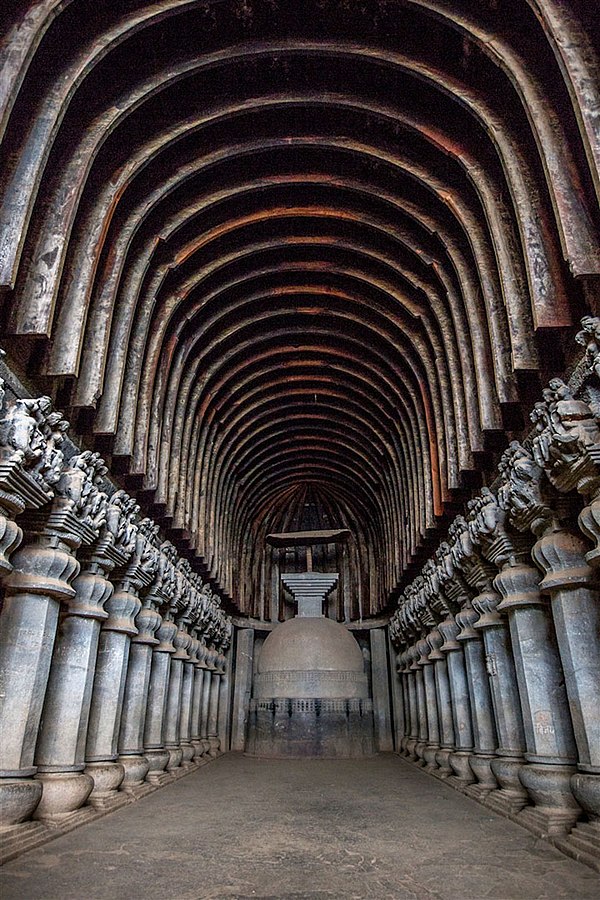
Karla caves Chaitya
The Karla Caves, Karli Caves, Karle Caves or Karla Cells, are a complex of ancient Buddhist Indian rock-cut caves at Karli near Lonavala, Maharashtra. The shrines were developed over the period – from the 2nd century BC to the 5th century AD.

Gol Gumbaz
Gol Gumbaz is the mausoleum of king Mohammed Adil Shah, Sultan of Bijapur. Construction of the tomb, located in Vijayapura, Karnataka, India, was started in 1626 and completed in 1656. The name is based on Gola gummata derived from Gol Gumbad meaning "circular dome". It follows the style of Deccan architecture.





